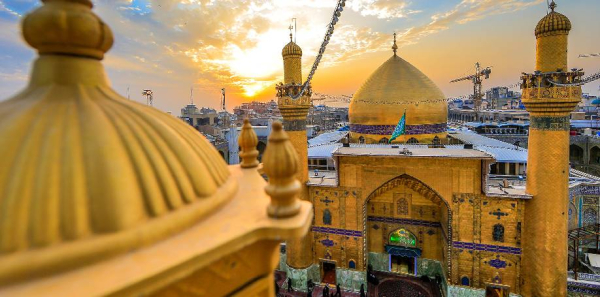The Letters of the Prophet
By M. Khoshdouz
Introduction
Islam as a universal message means for the entire human and race. God through some verses of the Quran has testified to this.1Furthermore, once the Prophet (s.w) was secretly preaching, announced to his relative that: I am the Messenger of God to you in particular, and to all people in general.2 This confirms that his mission was not just confined to his own people.
However, the oppressive policies of pagans in early years of his prophecy didn’t let him express the universality of his message practically3. It was just after the peace treaty of Hudaibyyah that Prophet (s.w) decided that the time has come to spread Islam to other territories.4 In other words, this peace treaty created a relatively safe environment for him to embark on the extending call of Islam to tribes and people far away from Arabia.5
As a result, in the seventh year of Hijra, in one day the Prophet (s.w) sent six men with letters inviting the rulers of Byzantium, Persia, Abyssinia (Ethiopia), Egypt, Ghassanians and Yamama (Jordan) to Islam.6 Just, one who is well verse in the political history of the time would arrive but this conclusion that only a true prophet (s.w) could dare to take such step.7 However, these letters were just a small portion of 62 letters of which the Prophet (s.w) sent to various kings, local rulers and chief of tribes.8
In due course, the Prophet (s.w) chose his deputies among the most proficient persons9and when he was informed that the rulers don’t entertain letter(s.w) s which don’t bear the seal, he made a seals on which were engraved: Muhammad, the Messenger of God.10
Letter of the Holy Prophet to the Byzantine Emperor, Heraclius
Dihyah bin Kalbi was the deputy of the Prophet to Heraclius.11 The messenger of the Prophet reached the emperor when he was making a journey on foot to Jerusalem in fulfillment of his vow for his splendid victory over the Persians.12 Unfortunately, historical sources are not unanimous on the chronology of the events. Some of them speak about a dream which the emperor had and was interpreted as falling of his Empire and the transmission of power to people with a different religion. As a result, when he was reported by an envoy of the Basra’s governor about a new Prophet he decided to find out more about it. It happened that some Meccan merchants like Abu Sufyan were in his territory for the trade. The Emperor summoned them and asked Abu Sufyan some questions about the Prophet (s.w).13 However, some other 2
historical sources say that it was subsequent to the reading of the Prophets’ letter that he demanded investigation. In the letter he was notified that if he embraces Islam he will be rewarded twice, for his conversion to Islam as well as his people’s conversion to Islam and on the contrary if he turns his face from Islam he will be responsible for the sins of his people and himself’s sins.14 Hearing that, the emperor informed the Bishop Daghtir about it. However, when the Bishop proclaimed the authenticity of the letter and announced his conversion to Islam he was killed by the zealous Romans who couldn’t tolerate it. Hence, although the emperor acknowledged the truth of the Prophet and wrote a letter in response, he didn’t embrace Islam, terrifying the same reaction.15
Letter of the Holy Prophet to the king of Iran, Chosroes
The deputy of the Prophet to the king of Iran, Chosroes was Abdullah Huzafah Shami.16 Historical sources attest that he was committed to deliver the letter of the Prophet to the ruler of Bahrain and then he gave it to Chosroes through his ambassador.17 The Prophet (s.w) had warned him in his letter by saying; “become Muslim and you will be safe. If you refuse to tell your people the message of God, you will be blame for the ignorance of your subjects”.18When Chosroes read the letter of the Prophet he got furious and tore it up and said: “My slave dares to write me thus!” 19Consequently, Chosroes ordered Bazan, the governor of Yemen to send someone to apprehend the Prophet (s.w). When Bazan’s men whose names have been mentioned different in sources told the Prophet (s.w) the command of the king, he asked them to withdraw and come the next day. Subsequently, when they visited the Prophet (s.w) the next day, he informed them of the slaying of Chosroes by the hand of his son, Sheeruyah. Then he asked them to carry this message to Bazan: “become a Muslim and your governorship will be safe”. When Bazan became aware of this he waited for a few days and as the truth of the Prophet’s prophecy manifested, he along with his Persian party embraced Islam.20
Letter of the Holy Prophet to the ruler of Abyssinia, Negus21
The Prophet’s deputy to the Negus was ‘Amr bin Umayyah. Since the Negus of Abyssinia had afforded protection to the Muslims from prosecution of pagans, the tone of the Prophet’s letter to him was kind and soft.22
“I call you to God, the Unique, without partner, to His obedience, and to fallow me and to believe in that which came to me, for I am the Messenger of God”.23
According to the historical sources the Negus of Abyssinia to whom the Prophet (s.w) sent a letter was not the Negus during whose reign the Muslim migrated to Abyssinia. However, the 3
sources testify that he humbled himself at the message of the Prophet and confessed his faith to Islam. He also replied the Prophet (s.w) and sent his son, Arha to him.24 Although he couldn’t make his people convert to Islam, when he died the Prophet (s.w) said his funeral prayer in absentia in Medina.25
Letter of the Holy Prophet to the ruler of Egypt, Maqauqis
The Prophet’s deputy to Maqauqis was Hatib bin Abi Blta’ah. The letter to him rather followed the same tone and content as the letter of the Prophet to Heraclius.26 Maqauqis didn’t accept Islam, but he treated the envoy of the Prophet with respect and honor.27 In his reply to the Prophet (s.w) he specified his believe on emerging the promised Prophet from Syria rather than Mecca.28 Nonetheless, he sent many presents to the Prophet (s.w) including Maria who gave birth to the Prophet’s son Ibrahim.29
Letter of the Holy Prophet to the Prince of the Ghassanians, Harith bin Abi Shamir
The Prophet’s deputy to Harith bin Abi Shamir was Shuja’ibn Wahab. The Prophet (s.w) had addressed him in his letter by saying: “If you embrace Islam your kingdom will continue to exist.” He didn’t accept Islam and even decided to dispatch someone in order to apprehend the Prophet (s.w). But when he informed his master of his decision, Heraclius didn’t pleas with it, thanks to the visiting the Prophet’s envoy and being acquainted with the message of Islam at the same time. As a result, his attitude altered and even he gave the envoy of the Prophet (s.w) a robe of honor.30 Soon after his denial, his power passed away and he died in the year of the conquest of Mecca.31
Letter of the Holy Prophet to the ruler of Yamamah, Hawzah bin Ali Hanafi
The Prophet’s deputy to the ruler of Yamamah was Salit bin ‘Amr. The message and the tone of the letter to him was virtually the same as the letter to the prince of Ghassanians. The ruler of Yamamah sent a delegation conveying this message to the Prophet (s.w) that he is prepared to embrace Islam provided that the Prophet (s.w) allows him to share some high religious status. Naturally, the Prophet (s.w) didn’t accept it and told in reply: “if his faith is conditional he is not fit for being ruler and God protect me from his mischief”.32 He also foretold that he would soon lose his domination.33
Conclusion
We can conclude that although the Prophet’s program was one of the “world-conquest”, he didn’t mean its realization by using force. He was neither an ambitious person nor had any 4
1 . Faruqui, Mumtaz Ahmad, Anecdotes from the Life of the Prophet Muhammad, Ahmadiyya Anjuman Isha’at Islam Lahore USA, 2011; this book is available at: https://books.google.com/.
2 . Noor, Ismail, Altruistic Service Leadership: Prophet Muhammad’s Model, Partridge Publishing Singapore, 2015; this book is available at: https://books.google.com/.
3 . Letters of the Prophet; this article is available at: http://islamicencyclopedia.org/.
4 . Life of the Prophet Muhammad (PBUH), p. 63.
5 . Altruistic Service Leadership: Prophet Muhammad’s Model; this book is available at: https://books.google.com/.
6 . Al-Majlisi, 'Akmal, The life and religion of Mohammed, as contained in the Sheeah traditions of the Hyat-ul-kuloob. (Hayah al-qulub.), Transl. by Rev. James L. Merrick, Phillips, 1850, P. 277.
7 . Islam House, The Biography of the Prophet, May God praise him, ideas4islam, p. 170.
8 . Dar Rah Haqq, A Glance at the Life of the Holy Prophet of Islam, Translated by N. Tawheedi, Mostazafan Foundation of New York; this book is available at: https://www.al-islam.org/.
9 . Subhani, Jafar, The Message, Islamic Seminary Publication; this book is available at: https://www.al-islam.org/.
10 . Muhammad Ahmad, Bashiruddin, Prophet Muhammad’s Letters to Various Kings, 2013; this article is available at: http://islam.ru/.
11 . The Message; this book is available at: https://www.al-islam.org/.
12 . Anecdotes from the Life of the Prophet Muhammad; this book is available at: https://books.google.com/.
13 . The Message; this book is available at: https://www.al-islam.org/.
14 . Anecdotes from the Life of the Prophet Muhammad; this book is available at: https://books.google.com/.
15 . The Life of the Prophet Muhammad (PBUH), pp. 64-65.
16 . The Message; this book is available at: https://www.al-islam.org/.
17 . Letters of the prophet; this article is available at: http:// islamicencyclopedia.org/.
18 . The Life of the Prophet Muhammad (PBUH), p. 65.
19 . The Biography of the Prophet, p. 175.
interest in power. Rather his aim which is remained till today was the conquest of people’s hearts. 5
20 . The life and religion of Mohammed, as contained in the Sheeah traditions of the Hyat-ul-kuloob. (Hayah al-qulub.), p. 280-281.
21 . The official title of the king of Abyssinia was Nagusa Nagasht or king of kings of Ethiopia, The Biography of the Prophet, may God praise him, p. 174.
22 . The Message; this book is available at: https://www.al-islam.org/.
23 . Life of the Prophet Muhammad (PBUH), p. 66.
24 . The life and religion of Mohammed, as contained in the Sheeah traditions of the Hyat-ul-kuloob. (Hayah al-qulub.), p. 281.
25 . Biography of the Prophet, p. 179.
26 . The Message; this book is available at: https://www.al-islam.org/.
27 . The Biography of the Prophet, may God praise him, p. 179.
28 . Al-Mubarakpuri, Saifur Rahman, The sealed nectar, Рипол Классик, pp. 158-159.
29 . The Biography of the Prophet, p. 179.
30 . The Message; this book is available at: https://www.al-islam.org/.
31 . The life and religion of Mohammed, as contained in the Sheeah traditions of the Hyat-ul-kuloob. (Hayah al-qulub.), p. 281.
32 . The Message; this book is available at: https://www.al-islam.org/.
33 . The life and religion of Mohammed, as contained in the Sheeah traditions of the Hyat-ul-kuloob. (Hayah al-qulub.), p. 281.


















